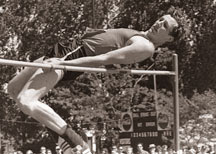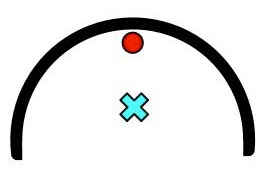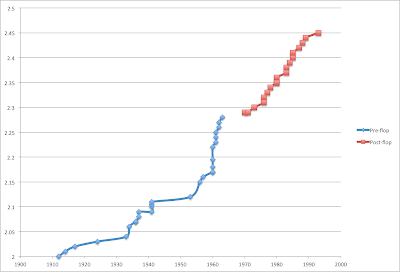Physics in Sports: The Fosbury Flop
 Physics
has greatly influenced the progress of most sports. There have been
continual improvements in equipment for safety or performance as well as
improvements in technique. I'd like to talk about some physics in sports
over a series of posts. Here I'll talk about a technique improvement in
High Jumping, the Fosbury Flop. The Fosbury Flop came into the High
Jumping scene in the 1968 Olympics, where Dick
Fosbury used the technique
to win the gold medal. The biggest difference between the Flop and
previous methods is that the jumper goes over the bar upside down
(facing the sky). This allows the jumper to bend their back so that
their arms and legs drape below the bar which lowers the center of mass
(See the picture above). Here is a video of the Fosbury
Flop executed very well.
Physics
has greatly influenced the progress of most sports. There have been
continual improvements in equipment for safety or performance as well as
improvements in technique. I'd like to talk about some physics in sports
over a series of posts. Here I'll talk about a technique improvement in
High Jumping, the Fosbury Flop. The Fosbury Flop came into the High
Jumping scene in the 1968 Olympics, where Dick
Fosbury used the technique
to win the gold medal. The biggest difference between the Flop and
previous methods is that the jumper goes over the bar upside down
(facing the sky). This allows the jumper to bend their back so that
their arms and legs drape below the bar which lowers the center of mass
(See the picture above). Here is a video of the Fosbury
Flop executed very well.
 Let’s
assume Dick Fosbury is shaped like a semi-circle as he moves over the
bar. The bar is indicated as a red circle, as this is a side view. From
this diagram, we can guess his center of mass is probably near the
marked 'x', since most of his mass is below the bar. It is important to
recall the definition of center of mass, which is the average location
of all of the mass in an object. $$ \vec{R} = \frac{1}{M} \int
\vec{r} dm $$ Note that this is a vector equation, and the integral
should be over all of the mass elements. This integral gets easier
because I'm going to assume that Dick Fosbury is a constant density
semi-circle. This means that $$ M = Ch $$ where C is a constant equal
to the ratio of the mass to the height, and $$dm = C * dh $$. This is a
vector equation, so in principle we need to solve the x integral and the
y integral; however, due to the symmetry about the y-axis, the x
integral is zero. Finally we'll convert to polar coordinates, leaving us
with: $$ y = \frac{1}{C \pi R} \int_0^\pi R\sin{\theta} C R
d\theta = \frac{1}{C \pi R} R (-\cos{\theta}) C R \bigg|_0^\pi
= \frac{2R}{\pi} $$ Ok, so this is the y-coordinate of the center of
mass of our jumper relative to the bottom of the semi-circle. Now we
need to calculate relative to the top of the bar, which is roughly the
location of the top of the circle. We just need to subtract from R: $$ R
- \frac{2}{\pi} R = R * (1 - \frac{2}{\pi}) = \frac{h}{\pi} * (1
- \frac{2}{\pi}) $$ Now Dick Fosbury was 1.95m tall, which gives us a
distance of 22.6 cm BELOW the bar! Of course he's not a semi-circle, but
this isn't a terrible approximation, as you can see from the video
linked above. Further, wikipedia mentions that some proficient jumpers
can get their center of mass 20 cm below the bar, which matches pretty
well with our guess. A nifty technique in physics is looking at the
point-particle system, which allows us to see the underlying motion of a
system. If you’re not familiar with this method, you collect any given
number of objects and replace them with a single point at the center of
mass of the object. We can use energy conservation now for our
point-mass instead of the entire body of the jumper.^note^ In
this case, we can simply deal with the center of mass motion of the
jumper. All of my kinetic energy will be converted to gravitational
potential energy. Again this is an approximation because some energy is
spent on forward motion, as well as the slight twisting motion which
I'll ignore. $$E = \frac{1}{2} mv^2 = mgh$$ Now let’s look at some
data. Here is a plot of each world record in the high jump.
Let’s
assume Dick Fosbury is shaped like a semi-circle as he moves over the
bar. The bar is indicated as a red circle, as this is a side view. From
this diagram, we can guess his center of mass is probably near the
marked 'x', since most of his mass is below the bar. It is important to
recall the definition of center of mass, which is the average location
of all of the mass in an object. $$ \vec{R} = \frac{1}{M} \int
\vec{r} dm $$ Note that this is a vector equation, and the integral
should be over all of the mass elements. This integral gets easier
because I'm going to assume that Dick Fosbury is a constant density
semi-circle. This means that $$ M = Ch $$ where C is a constant equal
to the ratio of the mass to the height, and $$dm = C * dh $$. This is a
vector equation, so in principle we need to solve the x integral and the
y integral; however, due to the symmetry about the y-axis, the x
integral is zero. Finally we'll convert to polar coordinates, leaving us
with: $$ y = \frac{1}{C \pi R} \int_0^\pi R\sin{\theta} C R
d\theta = \frac{1}{C \pi R} R (-\cos{\theta}) C R \bigg|_0^\pi
= \frac{2R}{\pi} $$ Ok, so this is the y-coordinate of the center of
mass of our jumper relative to the bottom of the semi-circle. Now we
need to calculate relative to the top of the bar, which is roughly the
location of the top of the circle. We just need to subtract from R: $$ R
- \frac{2}{\pi} R = R * (1 - \frac{2}{\pi}) = \frac{h}{\pi} * (1
- \frac{2}{\pi}) $$ Now Dick Fosbury was 1.95m tall, which gives us a
distance of 22.6 cm BELOW the bar! Of course he's not a semi-circle, but
this isn't a terrible approximation, as you can see from the video
linked above. Further, wikipedia mentions that some proficient jumpers
can get their center of mass 20 cm below the bar, which matches pretty
well with our guess. A nifty technique in physics is looking at the
point-particle system, which allows us to see the underlying motion of a
system. If you’re not familiar with this method, you collect any given
number of objects and replace them with a single point at the center of
mass of the object. We can use energy conservation now for our
point-mass instead of the entire body of the jumper.^note^ In
this case, we can simply deal with the center of mass motion of the
jumper. All of my kinetic energy will be converted to gravitational
potential energy. Again this is an approximation because some energy is
spent on forward motion, as well as the slight twisting motion which
I'll ignore. $$E = \frac{1}{2} mv^2 = mgh$$ Now let’s look at some
data. Here is a plot of each world record in the high jump.
 The
blue data show jumps before the Flop, and the red data show records
after the Flop. Note: In 1978, the straddle technique broke the
world record, being the only non-flop technique to do so since 1968.
Thanks Janne! The Flop was revealed in 1968, so I’ll assume that all
jumps before this year used a method where the center of mass of the
jumper was roughly even with the bar, while all jumps after this year
used the flop (see the previous note). Clearly something happened just
before the Flop came out, and this is something called the Straddle
technique. I want to
know the percent difference in the initial energies required, so I will
calculate $$ 100\% * \frac{E_0-E_f}{E_0} = 100\%
\frac{mgh_0-mgh_f}{mgh_0} = 100\% * \frac{h_0-h_f}{h_0} $$
where $$E_0$$ is the initial energy without the force, err the flop,
and $$ E_f $$ is the initial energy using the flop. Since we are using
the point-particle system, the gravitational potential energy only cares
about the center of mass of the flopper, and we need to know the height
of the center of mass for a 2.45m flop, which is the current world
record. This corresponds to a flop center of mass height of 2.25m, which
gives us an 8.2% decrease in energy using the flop (versus a method
where the center of mass is even with the bar)! The current world record
is roughly 20 cm higher than it was when the flop came out. This could
be due to athletes getting stronger, but this physics tells us that some
of the height increase could have been from the technique change. To sum
up, the high jump competition, along with many other sports, is being
exploited by physics! [note] Here we're relying on the center of mass
being equal to something called the center of gravity of the jumper. The
center of mass is as defined above. The center of gravity is the average
location of the gravitational force on the body. This happens to be the
same as the center of mass if you assume we are in a uniform
gravitational field, which is essentially true on the surface of the
Earth.
The
blue data show jumps before the Flop, and the red data show records
after the Flop. Note: In 1978, the straddle technique broke the
world record, being the only non-flop technique to do so since 1968.
Thanks Janne! The Flop was revealed in 1968, so I’ll assume that all
jumps before this year used a method where the center of mass of the
jumper was roughly even with the bar, while all jumps after this year
used the flop (see the previous note). Clearly something happened just
before the Flop came out, and this is something called the Straddle
technique. I want to
know the percent difference in the initial energies required, so I will
calculate $$ 100\% * \frac{E_0-E_f}{E_0} = 100\%
\frac{mgh_0-mgh_f}{mgh_0} = 100\% * \frac{h_0-h_f}{h_0} $$
where $$E_0$$ is the initial energy without the force, err the flop,
and $$ E_f $$ is the initial energy using the flop. Since we are using
the point-particle system, the gravitational potential energy only cares
about the center of mass of the flopper, and we need to know the height
of the center of mass for a 2.45m flop, which is the current world
record. This corresponds to a flop center of mass height of 2.25m, which
gives us an 8.2% decrease in energy using the flop (versus a method
where the center of mass is even with the bar)! The current world record
is roughly 20 cm higher than it was when the flop came out. This could
be due to athletes getting stronger, but this physics tells us that some
of the height increase could have been from the technique change. To sum
up, the high jump competition, along with many other sports, is being
exploited by physics! [note] Here we're relying on the center of mass
being equal to something called the center of gravity of the jumper. The
center of mass is as defined above. The center of gravity is the average
location of the gravitational force on the body. This happens to be the
same as the center of mass if you assume we are in a uniform
gravitational field, which is essentially true on the surface of the
Earth.
Comments
Comments powered by Disqus